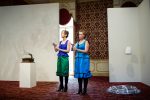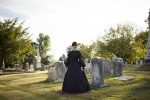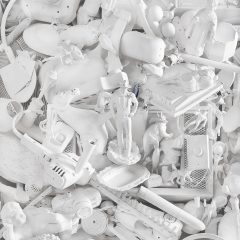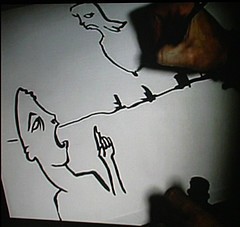Ed note: See part 1 of this interview here.
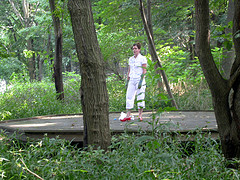
Lament, in Bartram’s Garden, last Saturday, July 29, 2006.
I met Martha McDonald at her house on the 2300 block of South St. where she and husband Alex Baker, Curator of Contemporary Art, Pennsylvania Academy of the Fine Arts, have an art-filled abode with a formidable array of surfboards hanging in the entryway. (They both surf although Alex is the major sufing practitioner, she said.) The back garden is lush and Martha is an avid gardener. She took me up to her studio on the 3rd floor where she writes and researches her performances. The L-shaped room has an open area with costumes from her various performances. There’s a harpsichord in the room and an electronic keyboard. The harpsichord was a gift from her late mother-in-law, Alex’s mother, Helen, who was a musicologist who performed and encouraged Martha to sing baroque music. Martha told me that growing up she studied piano for 9 years but doesn’t play now. She sang all throughout her school years including at Penn State from which she graduated with a degree in English.
Our talk concerned her new Bartram’s Garden piece (a collaboration with artist Katie Holten in conjunction with the ICA‘s Soft Sites exhibition) and about a new work she’s writing that is about the phenomenon of castrati. She’s very excited about the castrati project and has just returned from Berlin to visit her good friend Gregory Nelson who designs her costumes.
How do you know Gregory and what did you do in Berlin?
I met Gregory at Penn State. He was an art history major. He moved to LA and worked with the opera and now he’s in Berlin. I went to Berlin to dream and scheme on things.
The castrati project has been brewing in my mind for years. Diva Trouble (1999) was an exploration of the opera diva — from the castrati (the first opera divas) to Callas, the last to embrace diva-tude. I talked about castrati for 5 to 10 minutes in a 60-minute piece but I knew I wanted to get back to it.
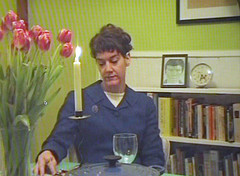
Drown’d in mine own tears, Philadelphia Live Arts Festival, 2005. All photos of Drown’d are taken from the DVD of the performance.
I read that your mother in law brought you to baroque music?
Alex’s mom was a musicologist. Helen had a Ph.D. in musicology. She taught for a while but then worked for ATT in the foreign section. That’s her harpsichord you saw in my studio. She gave it to me. She played the harpsichord and was a concert pianist. She was a huge early music lover. They had ensembles and they’d perform around New Jersey where they lived.
How did you get started singing?
I sang in the Penn State Singers. I always sang and took piano lessons for 9 years from 1st to 9th grades. My sisters did too. We sang in church.
Catholic?
Yes, Catholic. Music was part of life but I never thought of singing solo. Then in college I sang a solo in Dido and Aeneas.
It’s a small little opera, 5 people in the chorus. By Henry Purcell. That music opened my eyes to baroque music.
Then a couple years later I met Alex’s parents and they were excited to have a willing cohort. Helen would give me box sets to listen to and scores to read. I got this completely informal and completely passionate education (on early music).
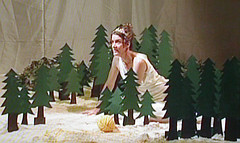
Drown’d in mine own tears, Philadelphia Live Arts Festival, 2005
Helen would play and I’d sing. She encouraged me to sing and to find my own voice. They were amazing people.
Did you play here in Philly?
We did one performance here in the first Unitarian church (not the basement where they do the rock music) but upstairs in a small room. And we would casually work on music. St. Steven’s curch on 7th we did another.
Then I formed Bella Donna, the Renaissance group with a mandolin, upright bass, violin, and I’d sing. And I’d be in costumes – I’d sew the costumes.
We performed 2-3 years. People loved it.
Where was this?
We played in coffee houses …the Big Mess Cabaret.
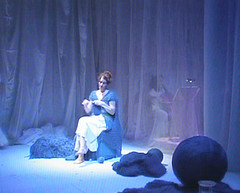
Drown’d in mine own tears, Philadelphia Live Arts Festival, 2005. Knitting was the motif than ran through the entire show.
They had queer aesthetics and it was usually benefits for Act Up.
Mostly it was really fun – and to make money for Act Up.
Once we got into Big Mess I got into theatre performance art. I met modern dancers and theatre people invited me to be in their piece.
And one dancer got me from being side-stage and with the music to moving around and interacting. I had wanted to move around to activate the musical performance.
The whole world opened up to me. Like when I did Dido and Aeneas.
When did the monologs come in?
That’s interesting. With Helen and with Bella Donna I would always introduce the music. Tell people the relevance of the music so people could dive in and not see it as a dusty old thing.
So I was already used to talking to an audience.
Then I saw some personal monologues. Greg Giovanni of Big Mess did lectures in Greek History. He’d deliver great monologues from Greek plays then would share personal stories when he was between monologues.
I thought—I could do that! Instead of monologues I could sing and then do things from my own life.
Elizabeth Mullins did something similar. With a lot of movement and some big props.
Then Bella Donna broke up as all bands do and I started working more with dancers. I wanted to make it my own. I wanted to mix in my writing…I was always a big journaler and I wrote short stories. So I combine my love of baroque music, my love of showing off, my love of entertaining and interplay with the audience.
Tell me about the first time you did your own kind of performance.
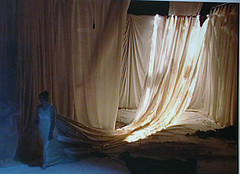
The ending of Drown’d has her attached to the walls of the house and straining to get away. I found the whole thing rich metaphorically and beautifully, opulently staged.
I applied to be at the CEC (Community Education Center in West Philadelphia) and got in. Three people each got a 20-minute slot and you got a little money. I did Myself I shall Adore. It’s about Semele, one of Zeus’s favorite mortal ladies. She got greedy. She wanted to have sex with Zeus when he was a god (he always came down to her in the form of a human). So he finally said ok and she was destroyed.
The music is a Handel oratorio.
Semele sings this vanity…what do women see when they look in the mirror. I was speaking as Semele. And as Judith with Holofernes. It was my first foray into the form. I researched and wrote the script. Liz Bonaventura made a baroque rug with text and a faux mirror frame (nothing in the middle) with thrift shop things all spray painted gold. It really looked like a baroque mirror.
I’ve done collaborations with visual artists to create things to help tell the story.
Why all the mythology?
I love mythological characters. They’re so larger-than-life but so true. Baroque is from 1640-mid 1700s. Everyone was obsessed with mythological themes. There are great arias to sing.
I’m compelled to relate… how do I relate to this character. Why should we care? It’s important to find my way in. it grounds it….I relate on some dark level, deep sense of hurt, paint, not fitting it, etc. Those are my issues. Why I relate.
Mix all those things that don’t go together –sad stories from my own life – with frilly songs, and sets and props that suggest a story.
The voices of your characters are often ambiguous…Who’s talking or singing at any one time is not clear. Is it Martha or Semele or someone else. I like the ambiguity.
I often feel I’m flitting back and forth. Some audiences struggle. I’m not a monologist who takes a different approach. I wasn’t trained as an actress. That’s not what I’m about. I’m interested in mining the conflicts and inconsistencies in myself.
Sometimes I think I’m the only one in the world (with these issues)…but really everyone has this complicated mix.
Tell me about the structure of your pieces.
There’s always a character, a guide….A tour guide. Then there’s the confessional. Then there’s the singer side. That’s pure raw emotion.,
Do you get feedback?
I’ve gotten the whole gamut.
Has you tweaked the form over time?
I’ve changed it. Originally I’d be “Hi I’m Semele or Hi I’m Penelope (stating clearly which character she was portraying at any given time) ….I moved away from that. I trusted more of what I was doing….the emotional content. I’ve stopped spoon feeding people.
When I’m in the audience I enjoy bringing my own perspective on things.
What do you like to see?
I really like dance. I don’t like to be talked at so much. …that’s why I stopped talking so much in my pieces.
I see way more movies and visual art. I go see opera, music. But I wouldn’t sit down and listen to a cd of opera…I need the visuals (the whole experience).
I try to see as much performance as I can, especially people mixing video and performance.
What do you think of Pig Iron Theatre…it’s multi-media, ever think of collaborating?
Pig Iron is considered the best in the country at what they’re doing—super physical, not verbal communication. Mime-like.
Do you consult with theatre people about your work?
I have people in the theatre community I talk to but I’m more like a visual artist is. I’m very alone. I’m not trained. I made it up as I went along. I’m an English major. I’m a writer. I’m not trained to work in ensemble. …A music group is different.
I created this solo performance piece on my own.
I studied with a voice teacher but haven’t been part of a musical group for years. I float from group to group and enjoy doing it.
Part 3 of this interview follows soon.


